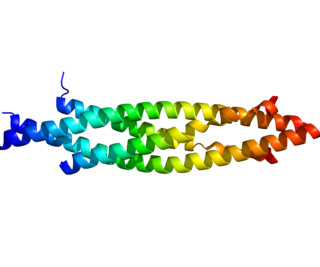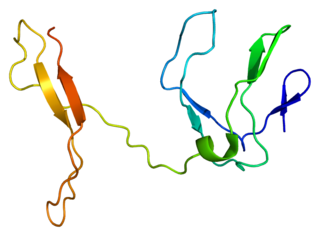
Nuclear factor kappa-light-chain-enhancer of activated B cells (NF-κB) is a protein complex that controls transcription of DNA, cytokine production and cell survival. NF-κB is found in almost all animal cell types and is involved in cellular responses to stimuli such as stress, cytokines, free radicals, heavy metals, ultraviolet irradiation, oxidized LDL, and bacterial or viral antigens. NF-κB plays a key role in regulating the immune response to infection. Incorrect regulation of NF-κB has been linked to cancer, inflammatory and autoimmune diseases, septic shock, viral infection, and improper immune development. NF-κB has also been implicated in processes of synaptic plasticity and memory.

NF-kappa-B essential modulator (NEMO) also known as inhibitor of nuclear factor kappa-B kinase subunit gamma (IKK-γ) is a protein that in humans is encoded by the IKBKG gene. NEMO is a subunit of the IκB kinase complex that activates NF-κB. The human gene for IKBKG is located on chromosome Xq28. Multiple transcript variants encoding different isoforms have been found for this gene.

IKK-β also known as inhibitor of nuclear factor kappa-B kinase subunithhv xlh thfbeta is a protein that in humans is encoded by the IKBKB gene.

Nuclear factor NF-kappa-B p105 subunit is a protein that in humans is encoded by the NFKB1 gene.
The IκB kinase is an enzyme complex that is involved in propagating the cellular response to inflammation.

IκBα is one member of a family of cellular proteins that function to inhibit the NF-κB transcription factor. IκBα inhibits NF-κB by masking the nuclear localization signals (NLS) of NF-κB proteins and keeping them sequestered in an inactive state in the cytoplasm. In addition, IκBα blocks the ability of NF-κB transcription factors to bind to DNA, which is required for NF-κB's proper functioning.

Transcription factor p65 also known as nuclear factor NF-kappa-B p65 subunit is a protein that in humans is encoded by the RELA gene.

Nuclear factor NF-kappa-B p100 subunit is a protein that in humans is encoded by the NFKB2 gene.

Inhibitor of nuclear factor kappa-B kinase subunit alpha (IKK-α) also known as IKK1 or conserved helix-loop-helix ubiquitous kinase (CHUK) is a protein kinase that in humans is encoded by the CHUK gene. IKK-α is part of the IκB kinase complex that plays an important role in regulating the NF-κB transcription factor. However, IKK-α has many additional cellular targets, and is thought to function independently of the NF-κB pathway to regulate epidermal differentiation.

Transcription factor RelB is a protein that in humans is encoded by the RELB gene.

The proto-oncogene c-Rel is a protein that in humans is encoded by the REL gene. The c-Rel protein is a member of the NF-κB family of transcription factors and contains a Rel homology domain (RHD) at its N-terminus and two C-terminal transactivation domains. c-Rel is a myeloid checkpoint protein that can be targeted for treating cancer. c-Rel has an important role in B-cell survival and proliferation. The REL gene is amplified or mutated in several human B-cell lymphomas, including diffuse large B-cell lymphoma and Hodgkin's lymphoma.

B-cell lymphoma 3-encoded protein is a protein that in humans is encoded by the BCL3 gene.

NF-kappa-B inhibitor beta is a protein that in humans is encoded by the NFKBIB gene.

Mitogen-activated protein kinase kinase kinase 14 also known as NF-kappa-B-inducing kinase (NIK) is an enzyme that in humans is encoded by the MAP3K14 gene.

TBK1 is an enzyme with kinase activity. Specifically, it is a serine / threonine protein kinase. It is encoded by the TBK1 gene in humans. This kinase is mainly known for its role in innate immunity antiviral response. However, TBK1 also regulates cell proliferation, apoptosis, autophagy, and anti-tumor immunity. Insufficient regulation of TBK1 activity leads to autoimmune, neurodegenerative diseases or tumorigenesis.

Inhibitor of nuclear factor kappa-B kinase subunit epsilon also known as I-kappa-B kinase epsilon or IKK-epsilon is an enzyme that in humans is encoded by the IKBKE gene.

Nuclear factor of activated T-cells 5, also known as NFAT5 and sometimes TonEBP, is a human gene that encodes a transcription factor that regulates the expression of genes involved in the osmotic stress.

TNFAIP3-interacting protein 2 is a protein that in humans is encoded by the TNIP2 gene. TNIP2 contains multiple amino acid sites that are phosphorylated and ubiquitinated.

Pirin is a protein that in humans is encoded by the PIR gene.

Nuclear factor of kappa light polypeptide gene enhancer in B-cells inhibitor, delta also known as IκBNS is a protein in humans that is encoded by the NFKBID gene.






















